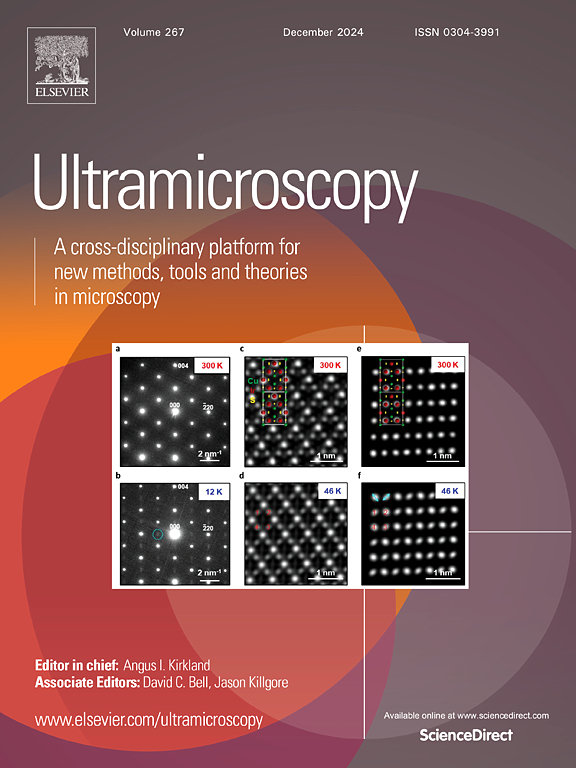High-Resolution EELS in an aberration-corrected LEEM: Design of electrostatic transfer lenses for hemispherical filters
IF 2
3区 工程技术
Q2 MICROSCOPY
引用次数: 0
Abstract
Recent advances in Low-Energy Electron Microscopy (LEEM), including the development of aberration-corrected (AC) systems, have significantly enhanced spatial resolution. However, further progress is limited by the energy resolution of current instruments. In this work, we propose a novel approach to address this limitation by integrating two Hemispherical Deflector Analyzers (HDAs) in tandem: the first serving to monochromatize the electron source, and the second to enhance the spectroscopic performance of AC-LEEM for Electron Energy Loss Spectroscopy (EELS). This dual-HDA configuration provides a clear pathway toward combining high spatial and energy resolution, expanding the capabilities of LEEM for advanced surface and materials characterization. This paper discusses various criteria for implementing these HDAs on a commercial AC-LEEM and presents more specifically the design of four transfer lenses (TLs) for electron transfer between the HDAs and the other optical components of the instrument. The use of a natural aberration correction scheme based on the dispersion-compensation (DC) principle is also discussed for maximum current throughput. Using ray-tracing simulations, we first show that the TL design can effectively decelerate/accelerate the electrons between 0.1 and 15 keV, thus respecting the high-voltage operation of the AC-LEEM. A double focus of the electron beam is also simulated so that the electron positions are conserved after transfer at the exit/entrance of the HDAs, an important condition for DC operation. Finally, ray-tracing simulations of the TLs show that the focal plane can be switched from the image plane to the back focal plane, allowing fast switching between diffraction and imaging modes.
像差校正LEEM中的高分辨率EELS:半球形滤光片静电转移透镜的设计
低能电子显微镜(LEEM)的最新进展,包括像差校正(AC)系统的发展,显著提高了空间分辨率。然而,进一步的进展受到现有仪器能量分辨率的限制。在这项工作中,我们提出了一种新的方法,通过将两个半球偏转器分析仪(HDAs)串联在一起来解决这一限制:第一个用于电子源单色化,第二个用于增强AC-LEEM用于电子能量损失光谱(EELS)的光谱性能。这种双hda配置为结合高空间和能量分辨率提供了一条清晰的途径,扩展了LEEM用于高级表面和材料表征的能力。本文讨论了在商用AC-LEEM上实现这些hda的各种标准,并更具体地介绍了用于hda和仪器其他光学元件之间电子转移的四个转移透镜(TLs)的设计。本文还讨论了基于色散补偿(DC)原理的自然像差校正方案的使用,以获得最大的电流吞吐量。通过射线追踪模拟,我们首先证明了TL设计可以有效地在0.1到15 keV之间减速/加速电子,从而尊重交流leem的高压工作。模拟了电子束的双聚焦,使得电子在HDAs出口/入口转移后的位置守恒,这是直流运行的重要条件。最后,射线追踪模拟表明,焦平面可以从成像平面切换到后焦平面,从而可以在衍射和成像模式之间快速切换。
本文章由计算机程序翻译,如有差异,请以英文原文为准。
求助全文
约1分钟内获得全文
求助全文
来源期刊

Ultramicroscopy
工程技术-显微镜技术
CiteScore
4.60
自引率
13.60%
发文量
117
审稿时长
5.3 months
期刊介绍:
Ultramicroscopy is an established journal that provides a forum for the publication of original research papers, invited reviews and rapid communications. The scope of Ultramicroscopy is to describe advances in instrumentation, methods and theory related to all modes of microscopical imaging, diffraction and spectroscopy in the life and physical sciences.
 求助内容:
求助内容: 应助结果提醒方式:
应助结果提醒方式:


